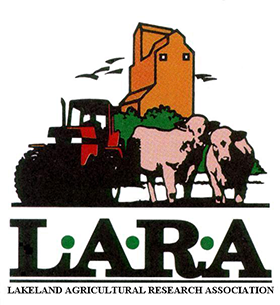Canola Fertility Trials
Background:
The high input costs of canola production, particularly fertilizer costs, have producers questioning the recommended rates of nitrogen fertilizer and if these rates can be reduced while maintaining optimum yields.
There is also increasing interest in more efficient nitrogen fertilizer products including ESN (Environmentally Smart Nitrogen). After application of conventional nitrogen fertilizer (46-0-0-0), it is quickly utilized or dissipated into the environment through leaching, volatilization or denitrification. To help prevent this loss, researchers are seeking out slow-release nitrogen fertilizer solutions. One of these products is ESN, manufactured by Agrium, a 44-0-0-0 fertilizer covered with a polymer coat that prevents immediate dissipation. This allows for more sustained release of nitrogen to the plant over the growing season.
In response to increasing canola acres and high input costs, LARA began the Canola Fertility Trial in 2012 to look at the impacts of different nitrogen fertilizer rates on yields and to determine if there are difference in yield between conventional and ESN fertilizers.
Objectives:
- To determine the impacts of varying rates of nitrogen fertilizer on canola yields.
- To determine canola yield differences when comparing conventional nitrogen and ESN at varying rates.
Method:
This year, LARA established one site of fertility trials at the LARA Research Farm in Fort Kent (NE25-61-05-W4). The trials were seeded using the LARA five-row Fabro zero-till drill in a complete randomized block design on May 23, 2014 (Fort Kent) and June 3, 2014 (Lac La Biche). All plots were seeded to 7255 RR Canola at 0.75” deep. Plots measured 1.15m x 6m in area.
Two trials were established in Fort Kent with a canola blend trial and a sulphur fertility trial, while a canola blend trial was seeded in Lac La Biche. The trial treatments can be found in Table 1 and Table 2. A soil sample was taken in the spring to determine nutrient requirements and a recommended fertilizer blend was constructed. The trial sites were pre-burned with RoundUp prior to seeding and in-crop herbicides applications were done in early July.
Results:
The Canola Blend Fertility Trial results can be seen in Table 3 and demonstrates that an increase in N fertilizer rates results in an increase in canola yield. The lowest yielding treatment was the check (no fertilizer applied) at 40 bu/acre while the highest yielding treatment was the blend applied at 200% of the recommended rate (70 bu/acre). This suggests that the recommendations based on the soil test taken in the spring underestimated the N requirements for canola. The soil tested was a composite sample of the Fort Kent Research Site and, due to field variability, may not have been an accurate representation of the area in which the trial was seeded.
Click here to view complete report.

